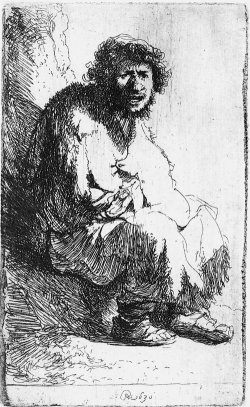
Rembrandt painting
of a homeless man
|
| Chicago, 1977. Mid-autumn.
A 55 year old homeless man presented with cough and difficulty swallowing.
He had smoked 1-2 packs of
cigarets daily since age 11, and drunk heavily through
most of his adult life. He had been brought to the emergency room by friends because of a
cough and weight loss of approximately 25 lb during the past two months.
daily since age 11, and drunk heavily through
most of his adult life. He had been brought to the emergency room by friends because of a
cough and weight loss of approximately 25 lb during the past two months.
The patient stated that while he has no difficulty swallowing liquids,
solid food seems to stick in his chest. "It makes it half way down, then stops for a while, hands up kind of."
He did not believe he ever choked or aspirated, and that except for some beef that he had vomited,
most of the food eventually made it to his stomach.
He says his cough is non-productive, and that he thinks he may have had a fever.
He denies regurgitation, heartburn, hemoptysis, chest pain, and night sweats.
Physical exam shows a slender man 5'10" and weighing 105 lb.
He is lucid, oriented, and pleasant.
There is no odor of ethanol, no tremulousness, and he says his last drink of alcohol abuse was
about 18 hours ago.
He says he may be interested in stopping drinking at some time in the future.
Temperature is 99.5 F, pulse 90, respirations 28. Physical exam is remarkable for increased chest diameter, coarse
and increased breath sounds, and some examiners felt there were patchy "velcro" rales.
It was specifically noted that there was no cyanosis.
Which would you do now? Choose all that apply.
|